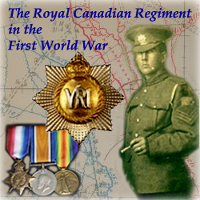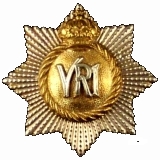
The First World War
War Diary of The Royal Canadian Regiment
Transcription by Captain Michael O'Leary, The RCR.
AUGUST 1916
APPENDIX 10
NOTES ON THE HISTORY OF THE REGIMENT
The Regiment was first formed on the 21ST December, 1883, for the purpose of Instructing the Canadian Militia and for this reason it was called The Infantry School Corps. Since that time however, the name of the Regiment has changed several times, first to the Royal Regiment of Canadian Infantry (R.R.C.I.) then to the Royal Canadian Regiment of Infantry (R.C.R.I.) and finally to THE ROYAL CANADIAN REGIMENT (R.C.R.) which name we have retained to the present time. We are sometimes confused with the Leinsters who are Royal Canadians but it must be borne in mind that we are The Royal Canadians. In addition to this honour, we have other distinctions of which we are justly proud. Our buttons and cap badge have V.R.I. on them. These letters stand for Victoria Regina Imperatrix which being translated, means, Victoria Queen and Empress (of India). Now this distinctive mark was given to us by the late Queen Victoria which is one of the facts of which we are most proud. The Militia Department of Canada have always tried to take it away from us, but, in spite of all, we have retained it and we all sincerely trust that we shall continue to do so.
Our collar badge consists of a beaver with Pro Patria inscribed beneath it. These words signify "For our Native Country". The Beaver as you know is essentially a Canadian badge and stands as the emblem of Industry and Perseverance. These distinctions which I have enumerated and dealt with, we carry with us. We wear them every day with a feeling of pride. The Regiment possesses others, which however had to be left behind in Halifax for safe keeping.
In 1885 we took part in the North West Rebellion and were under General Middleton in the fighting at Batosch [sic] and Cut Knife Creek. We have these honours on our colours. In addition to this we have in the Officers' Mess, a North West Campaign Centre piece, designed by Miss Buchan (now Mrs. J.H. Kaye) and presented to us by the citizens of Toronto.
In 1899 The Regiment proceeded to South Africa and took part in that campaign doing particular good service at Paardeberg. We were in the 19TH Bde. Which consisted of the Shropshires, Gordons, D.C.L.I. and ourselves. For this we also have Paardeberg and South Africa on our colours.
After the war, the late King Edward, in recognition of the services we rendered, presented tus with a special colour, i.e., a second King's colour. This is a distinction of which I think only two or three other Regiments can boast. We have therefore, two Kings' colours and our Regimental colour, with the honours I have mentioned on it, all of which are now in Halifax.
The above notes are for the guidance of officers in compiling a short lecture to be delivered to their men at as early a date as possible.
(signed)
F. Dickson
Lieut.
Asst. Adjutant, The Royal Canadian Regiment.
- The O'Leary Collection; Medals of The Royal Canadian Regiment.
- Researching Canadian Soldiers of the First World War
- Researching The Royal Canadian Regiment
- The RCR in the First World War
- Badges of The RCR
- The Senior Subaltern
- The Minute Book (blog)
- Rogue Papers
- Tactical Primers
- The Regimental Library
- Battle Honours
- Perpetuation of the CEF
- A Miscellany
- Quotes
- The Frontenac Times
- Site Map

![]() The RCR in the Great War
The RCR in the Great War
![]() War Diary
War Diary
![]() Battle Honours
Battle Honours
![]() Battle Bars and The RCR
Battle Bars and The RCR
![]() The RCR Battle Bar Ledger (pdf)
The RCR Battle Bar Ledger (pdf)
![]() Honours and Awards
Honours and Awards
![]() Roll of Honour
Roll of Honour
![]() Prisoners of War
Prisoners of War
![]() Cemetery List
Cemetery List
![]() Cemetery Map
Cemetery Map
![]() Courts Martial
Courts Martial
![]() Officers
Officers
![]() RSMs of The RCR (1914-1919)
RSMs of The RCR (1914-1919)
![]() NCOs and Soldiers
NCOs and Soldiers
![]() An Officer's Diary (1914-1918)
An Officer's Diary (1914-1918)
![]() Recollections of a Nonagenerian (R. England) (1916-1919)
Recollections of a Nonagenerian (R. England) (1916-1919)
![]() On to Bermuda (1914-15)
On to Bermuda (1914-15)
![]() England and France 1915-1916 (Hayes; 1931)
England and France 1915-1916 (Hayes; 1931)
![]() Overseas with The Royals (1915)
Overseas with The Royals (1915)
![]() Regimental History Pamphlet (1917)
Regimental History Pamphlet (1917)
![]() Amiens (1918)
Amiens (1918)
![]() Cambrai (1918)
Cambrai (1918)
![]() Monchy-le-Preux (1918)
Monchy-le-Preux (1918)
![]() Under-aged Soldiers in The RCR
Under-aged Soldiers in The RCR
![]() Not All Were Volunteers; The RCR and the Military Service Act
Not All Were Volunteers; The RCR and the Military Service Act
![]() Sentenced to Death by Court Martial
Sentenced to Death by Court Martial
![]() The 7th Trench Mortar Battery
The 7th Trench Mortar Battery
![]() A Regimental Goat
A Regimental Goat
![]() Regiment and Family, Bermuda 1914-15
Regiment and Family, Bermuda 1914-15
![]() "March the Guilty Bastard In"
"March the Guilty Bastard In"
![]() Surrendered as Stowaway
Surrendered as Stowaway
![]() Re-Visiting the Great War Roll of Honour for The RCR
Re-Visiting the Great War Roll of Honour for The RCR
![]() Canadian Corps Trench Standing Orders (1916)
Canadian Corps Trench Standing Orders (1916)

